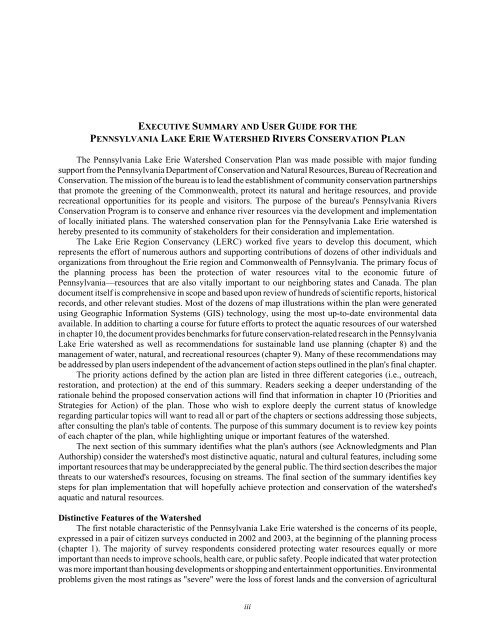Watershed Conservation Plan - Destination Erie
Watershed Conservation Plan - Destination Erie
Watershed Conservation Plan - Destination Erie
Create successful ePaper yourself
Turn your PDF publications into a flip-book with our unique Google optimized e-Paper software.
EXECUTIVE SUMMARY AND USER GUIDE FOR THE<br />
PENNSYLVANIA LAKE ERIE WATERSHED RIVERS CONSERVATION PLAN<br />
The Pennsylvania Lake <strong>Erie</strong> <strong>Watershed</strong> <strong>Conservation</strong> <strong>Plan</strong> was made possible with major funding<br />
support from the Pennsylvania Department of <strong>Conservation</strong> and Natural Resources, Bureau of Recreation and<br />
<strong>Conservation</strong>. The mission of the bureau is to lead the establishment of community conservation partnerships<br />
that promote the greening of the Commonwealth, protect its natural and heritage resources, and provide<br />
recreational opportunities for its people and visitors. The purpose of the bureau's Pennsylvania Rivers<br />
<strong>Conservation</strong> Program is to conserve and enhance river resources via the development and implementation<br />
of locally initiated plans. The watershed conservation plan for the Pennsylvania Lake <strong>Erie</strong> watershed is<br />
hereby presented to its community of stakeholders for their consideration and implementation.<br />
The Lake <strong>Erie</strong> Region Conservancy (LERC) worked five years to develop this document, which<br />
represents the effort of numerous authors and supporting contributions of dozens of other individuals and<br />
organizations from throughout the <strong>Erie</strong> region and Commonwealth of Pennsylvania. The primary focus of<br />
the planning process has been the protection of water resources vital to the economic future of<br />
Pennsylvania—resources that are also vitally important to our neighboring states and Canada. The plan<br />
document itself is comprehensive in scope and based upon review of hundreds of scientific reports, historical<br />
records, and other relevant studies. Most of the dozens of map illustrations within the plan were generated<br />
using Geographic Information Systems (GIS) technology, using the most up-to-date environmental data<br />
available. In addition to charting a course for future efforts to protect the aquatic resources of our watershed<br />
in chapter 10, the document provides benchmarks for future conservation-related research in the Pennsylvania<br />
Lake <strong>Erie</strong> watershed as well as recommendations for sustainable land use planning (chapter 8) and the<br />
management of water, natural, and recreational resources (chapter 9). Many of these recommendations may<br />
be addressed by plan users independent of the advancement of action steps outlined in the plan's final chapter.<br />
The priority actions defined by the action plan are listed in three different categories (i.e., outreach,<br />
restoration, and protection) at the end of this summary. Readers seeking a deeper understanding of the<br />
rationale behind the proposed conservation actions will find that information in chapter 10 (Priorities and<br />
Strategies for Action) of the plan. Those who wish to explore deeply the current status of knowledge<br />
regarding particular topics will want to read all or part of the chapters or sections addressing those subjects,<br />
after consulting the plan's table of contents. The purpose of this summary document is to review key points<br />
of each chapter of the plan, while highlighting unique or important features of the watershed.<br />
The next section of this summary identifies what the plan's authors (see Acknowledgments and <strong>Plan</strong><br />
Authorship) consider the watershed's most distinctive aquatic, natural and cultural features, including some<br />
important resources that may be underappreciated by the general public. The third section describes the major<br />
threats to our watershed's resources, focusing on streams. The final section of the summary identifies key<br />
steps for plan implementation that will hopefully achieve protection and conservation of the watershed's<br />
aquatic and natural resources.<br />
Distinctive Features of the <strong>Watershed</strong><br />
The first notable characteristic of the Pennsylvania Lake <strong>Erie</strong> watershed is the concerns of its people,<br />
expressed in a pair of citizen surveys conducted in 2002 and 2003, at the beginning of the planning process<br />
(chapter 1). The majority of survey respondents considered protecting water resources equally or more<br />
important than needs to improve schools, health care, or public safety. People indicated that water protection<br />
was more important than housing developments or shopping and entertainment opportunities. Environmental<br />
problems given the most ratings as "severe" were the loss of forest lands and the conversion of agricultural<br />
iii





